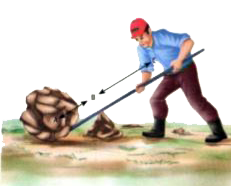If the effort arm is 1 m and the load arm is 150 cm long, find the MA.
The correct Answer is:0.67
To find the Mechanical Advantage (MA) given the effort arm and load arm, follow these steps:
1. Identify the lengths of the effort arm and load arm:
- Effort arm = 1 m
- Load arm = 150 cm
2. Convert the effort arm to centimeters:
- Since 1 m = 100 cm, the effort arm in centimeters is:
Effort arm=1m=100cm
3. Write down the formula for Mechanical Advantage (MA):
- The formula for Mechanical Advantage is:
MA=Effort armLoad arm
4. Substitute the values into the formula:
- Substitute the effort arm (100 cm) and load arm (150 cm) into the formula:
MA=100cm150cm
5. Calculate the MA:
- Perform the division:
MA=100150=23≈0.67
6. State the final answer:
- The Mechanical Advantage (MA) is approximately 0.67.
- Effort arm = 1 m
- Load arm = 150 cm
- Since 1 m = 100 cm, the effort arm in centimeters is:
Effort arm=1m=100cm
- The formula for Mechanical Advantage is:
MA=Effort armLoad arm
- Substitute the effort arm (100 cm) and load arm (150 cm) into the formula:
MA=100cm150cm
- Perform the division:
MA=100150=23≈0.67
- The Mechanical Advantage (MA) is approximately 0.67.
Topper's Solved these Questions
Similar Questions
In a class-three lever, the distance between the effort and the load is 25 cm, and the load arm is 0.75 m long. Find the length of the effort arm and then calculate MA.
View SolutionIn a class three lever, the distance between the effort and the load is 40 cm and load arm is 1 m long. Find the length of the effort arm and then calculate MA.
View SolutionCalculate the ideal mechanical advantage of a lever in which the effort arm is 60 cm and the load arm is 4 cm.
View SolutionIn a class two lever, the load arm is 80 cm long and the distance between the load and the effort is 120 cm. Find the MA.
View Solution
If the lever in the figure is 100 cm long and the length of the load arm is 20 cm, what would be the length of the effort arm?
View SolutionComplete the following sentence:
(a) Mechanical advantage=_____×velocity ratio
(b) In class II lever, effort arm is ____than the load arm.
(c) A pair of scissors is a ____multiplier.
View Solution
Label the load arm and effort arm in the figure.
View SolutionDraw a simple diagram ofa fire tongs and mark on it the fulcrum F and the points of application of load L and effort E. (a) Name the class of lever. (b) if load arm is 15 cm and effort arm is 5 cm. what is its mechanical adavantage?
View SolutionA lever of length 9 cm has its load arm 5 cm long and the effort arm is 9 cm long. (a) to which class does it belong ?
(b) Draw a diagram of the lever showing the position of the fulcrum F and directions of both the load L and effort E. (c) what is the mechanical advantage and velocity ratio if the efficiency is 100%?
(d) What will be the mechanical advantage and velocity ratio if the efficiency becomes 50%?
View SolutionA class-three lever has a length of 150 cm and the effort is applied at a distance of 50 cm from the fulcrum. The MA is
View Solution

